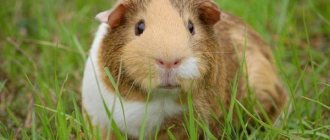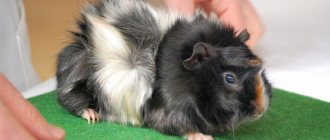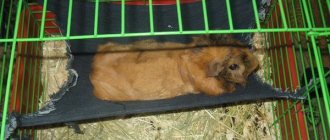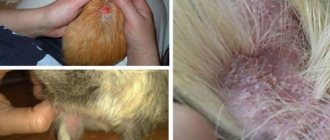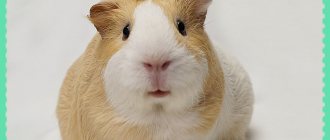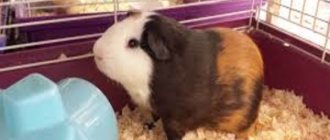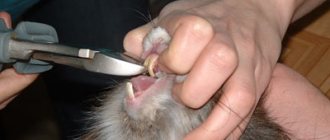Author Sergey Bukhransky
04.02.2019 20:54
Zoosphere » Rodents
Any pet needs proper care. Some are more difficult to care for, others are easier. However, every creature needs care. Guinea pigs are no exception here. Another thing is that these cute creatures with an easy-going character do not need complex and costly care. The only exception is pigs without hair or with very long hair.
Keeping a guinea pig in a cage
Advantages
Most owners prefer to keep their guinea pig in a rodent cage.
There are many advantages to such a home:
- compact;
- reliable;
- easy to move;
- convenient to wash;
- inexpensive;
- good ventilation.
Keeping animals in aquariums and terrariums is not recommended due to insufficient ventilation and complete isolation of the animal from the outside world, smells and sounds.
Cage requirements
What size should a cage be to keep a guinea pig at home? Design parameters depend on many factors. For active animals, it is better to purchase a larger cage; a rosette pig will prefer a small but comfortable home. There are requirements that must be applied to the cage of any rodent:
- Size. The minimum housing size for one animal is 40x80 cm, height – 50 cm.
- Pallet. The presence of a tray will make the cleaning process easier and eliminate the need to disturb your pet once again. The depth of the container should not be too large, otherwise the pig will not be able to look out. A shallow container will fill up quickly.
- Safety. The product should not have chips, cracks or other defects that could cause harm to the rodent. To avoid injury, it is better to choose a one-story structure.
- Zoning. The cage should have a play area and a place to rest.
Toys
Interesting toys will delight your guinea pig. But owners must remember what items are prohibited from being placed in a rodent’s cage:
- running wheels;
- walking balls;
- rings and bells on ropes.
Guinea pigs are slow and inflexible animals; they have weak spinal muscles. The following items can cause serious injury. Tunnels are great for stimulating physical activity. A good choice would be tennis or ping-pong balls, cubes, and any high-quality toys for leisure and grinding down the rodent's teeth.
Home improvement
Feeder
Feeders are divided into several types:
- floor;
- retractable;
- external.
The main requirement for the design is stability. If the animal rests its paws on the container, it should not tip over. The ideal option is a glass or ceramic feeder. A plastic product will also work, but it is not reliable. It is easy to move, turn over, or simply chew on it. Metal vessels are more reliable in this regard.
Sennik
For hay and green fodder you need a separate feeder or hay barn. Hay is the main source of protein in a rodent's diet. It must be present in the cell. The sennik will not allow the pig to scatter the food and get it dirty.
Drinking bowl
An ordinary bowl will also work as a drinking container. But an automatic drinker is much more convenient; it will provide the animals with constant access to drink, protect the water from contamination and prevent the animals from spilling liquid on the bedding. Plastic and glass containers are recommended for guinea pigs.
Filler
There are several options for cage bedding:
- Wood granular filler. Economical, but noisy option, absorbs moisture well.
- Sawdust. They absorb moisture and odors worse than granules, but are widely used because they are softer and do not require additional coating.
- PVC mat. It is convenient to lay on top of granules or sawdust.
- Corn filler. Hypoallergenic, but moisture can cause mold to form on it.
- Paper filler. Absorbs moisture well, absorbs odors poorly.
- Diapers. They can be laid under the filler, this will make cleaning easier.
- Fleece. It is aesthetically pleasing and pigs like it because it is very soft. It does not absorb moisture, but passes it through itself, remaining dry. You need to put another type of filler under the fleece.
The layer of litter should not exceed 5 cm. The filler should be changed as it gets dirty.
House
Rodents need a place to hide and rest. The houses are made of plastic, bark and wood. It is better to give preference to a bark shelter. The pig can grind its teeth on it.
Cell location
When choosing a place for an animal’s home and installing a cage, you need to remember:
- The cage should be at least 50 cm away from heating devices.
- The cage moves away from the wall approximately 30 cm.
- Cold air flows from the air conditioner should not reach the pet.
- It is not recommended to install the cage in the kitchen;
- Electrical appliances and equipment should be kept away from the animal.
Material of manufacture
The catalog of cages for animals presents different options, but many are not even worth considering. A bad material for keeping a guinea pig is wood. Although such cells look beautiful, they absorb dirt and odors. The rodent happily sharpens its teeth on wooden beams, destroying the cage.
Often in a pet store they try to force a terrarium or an aquarium on the buyer. The main argument is that dirt and sawdust will not fly into the room. But in such containers there is no ventilation. The animal will breathe fumes from excrement. In addition, the guinea pig’s brain is designed in such a way that the animal does not see what is happening behind the glass, and in such a house it will feel lonely.
Popular sections:
Aquariums Sale of kittens and puppies Terrariums Products for cats Products for dogs
The optimal composition of the cage is a plastic tray and metal rods. Such houses are durable, resistant to moisture, easy to wash and do not collapse under the influence of disinfectants.
Aviary for walks
In the warm season, you can build an enclosure on your balcony or dacha for walks in the fresh air, where the animal can at the same time enjoy fresh grass. Basic requirements for the product:
- the enclosure is made of wooden slats and metal mesh;
- the pen is installed on legs, since pigs should not be allowed to be on a wet floor;
- minimum pen dimensions: height - 50 cm, length - 100 cm, width - 50 cm;
- the design should protect pets from other animals.
Grooming: brushing
Short-haired guinea pigs do not need special care for their fur; they do an excellent job on their own. If you want to give your pet pleasure, you can pet him once a week with a soft, short-bristled brush. The pig will probably like this massage, and at the same time you will comb the fur and remove some dead hairs. Pigs without hair will not need a brush at all, but with long-haired pets you will have to tinker. Guinea pigs with wavy hair require special attention, since one straw or blade of grass is enough to create a tangle.
The long-haired animal requires your daily attention - 10-15 minutes. First, the fur needs to be combed with a sparse comb, removing specks and untangling tangles with your hands. Then you should comb the coat with a thick comb and finally go through it with a brush so that the coat becomes shiny and lays down as desired.
If you comb it daily, it will not cause any particular difficulties, but if you comb the animal less often, it will be a longer and more labor-intensive process. And it’s also unpleasant for your pet, because when combing matted fur, he experiences pain, and the tangles not only spoil the appearance, but also cause discomfort: the skin under them begins to swell and become inflamed. If the tangle cannot be sorted out, you need to use scissors and carefully cut it out.
Conditions of detention
Microclimate
Ideally, guinea pigs should be provided with:
- Space.
- Constant temperature range from 17 to 20 ⁰С.
- Optimal humidity levels are no less than 40% and no higher than 60%.
- Regular ventilation (but no drafts).
- Good lighting (but not direct sunlight).
Diet
To establish a diet, it is worth considering the breed of your pet. Rosette pigs and most other breeds eat 3 times a day in small portions - 2 tablespoons. Skinny the guinea pig has a big appetite, her portions should be larger, and in the evening you can include an additional portion of succulent food in her menu.
The pet may not eat the entire portion at once, then the feeder must be left in the cage so that the rodent can eat later.
The animal should always have free access to:
- hay and green fodder;
- dry food;
- pure water;
- branches of fruit trees;
- salt and mineral stones.
Cleaning
Guinea pigs' homes need to be cleaned periodically. Regular cleaning and disinfection of the cage is the key to the health, good mood and beauty of pets.
General cleaning is performed in the following order:
- Guinea pigs are placed in a shipping crate or released for a walk.
- All equipment is removed from the home and thoroughly washed in soapy water.
- Next, the equipment is rinsed with clean water and treated with boiling water or a disinfectant.
- The filler is removed.
- Then you need to wash the cage with a disinfectant and rinse with clean water.
- New filler is lined.
- The equipment is installed in place.
- It is necessary to let the house dry a little before returning the animal to it.
- The pig returns to its place.
Special mixtures for disinfection can be used, but strong disinfectants are prohibited. Simple bleach or vinegar essence is also suitable for treating the cell.
Design
An important point when choosing a cage for a pet is the correct design. You cannot take a cage for birds, hamsters, ferrets or any other pets. Such structures are dangerous for a guinea pig because they are too high and do not have a clear division into floors, and the pet can get injured in them. Remember other useful tips:
- The safe height for the animal is 10-15 centimeters; objects and accessories cannot be placed above this mark.
- Choose houses of rectangular or square shape (the main thing is large width).
- The removable cage cover makes cleaning easy.
- If you have several pets or plan to breed them, choose cages with dividing panels and ramps.
- If you travel frequently, buy a crate that can be disassembled and assembled so you can take your pet with you.
Shared content
How to choose a pair
Guinea pigs are one of the most peaceful and sociable animals. Therefore, it is recommended to keep two or more rodents of the same sex at once.
You cannot house the first animals you come across together.
You need to choose a pair wisely:
- It is not worth keeping a male and a female together if you do not plan to breed animals. The boy will annoy the girl with his advances; in response, she may spray the gentleman with a stream of urine and run away.
- It is ideal to purchase two babies of the same sex at once.
- It is acceptable to place the baby with an already adult pig, which will not perceive the baby as a threat.
- Two males and a female in one cage cannot live peacefully. The males will pester the female and fight with each other.
If adult rodents are purchased, it is better to give preference to females.
Food
A healthy diet will prolong the life and improve the health of your pet. Remember the correct diet of the animal:
- hay – 60%;
- vegetable and fruit components, greens – 30%;
- dry food – 10%.
The main product on the animal’s menu is hay. It forms healthy digestion for your pet and supplies it with all the necessary substances and vitamins. The most useful is considered to be hay made from cereals and beans, clover, alfalfa, and nettle. Hay is purchased or prepared independently.
Guinea pigs are primarily herbivores, so the menu should include seasonal fruits and vegetables. Pieces that are not eaten before the next feeding are thrown away. Your pet's daily diet should include at least 5 types of vegetables and herbs. The animal is offered sprouted grains and seeds, branches of trees and shrubs along with leaves and flowers (acacia, birch, maple, poplar). Remember that many plants, such as lilacs, and most indoor flowers are poisonous to guinea pigs.
Claw care
Claws on the paws do not grow quickly, but eventually reach an unaesthetic length and begin to interfere with the pet’s hygiene. On the front paws, overgrown nails curl up and interfere with walking, causing deformation of the toes. This is why your guinea pig’s claws need to be trimmed a couple of times a year. To do this, you will need special tweezers or the smallest nail clippers, as well as a regular nail file.
The claw must be trimmed so as not to touch the blood vessels, otherwise severe bleeding will begin and the animal will experience unbearable pain. Nail trimming should be done carefully and without haste. The cut should be made strictly perpendicular to the growth line so that they do not delaminate during the pruning process.

